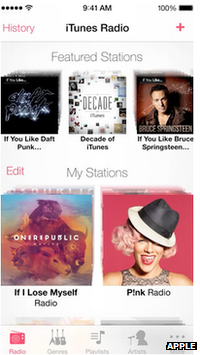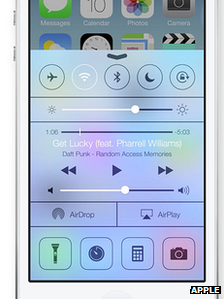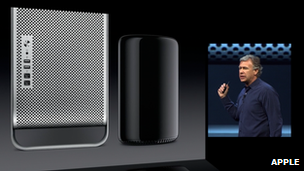Apple reveals iOS 7 design revamp and iTunes Radio
- Published

iOS 7 aims to offers a cleaner user interface to iPhone and iPad owners
Apple reveals iOS 7 design revamp
Apple has unveiled a brighter look for the user interface of its smart device iOS operating system - the first to be overseen by its design chief Jony Ive.
He said the aim was to make the system look "cleaner" to help "elevate" users' content.
It involves a shift away from skeuomorphism - the use of leather, wood and other real-world inspired textures and artifacts in apps.
A similar change has also been made to the OS X system for Mac computers.
Highlighting the new look of the firm's Game Center app, Apple's senior vice president of Software Engineering Craig Federighi joked: "We just completely ran out of green felt and wood - this has got to be good for the environment."
He also showed off a parallax effect which means icons shift against the background image as an iPhone-user tilts their handset one way and another, based on feedback from the device's accelerometer sensor.
"The new version is almost unrecognizable, which will make it polarising," said Jan Dawson, chief telecoms analyst at the consultancy Ovum.
"Some people will love that their phone feels new and different, while others will be disoriented by the newness.
"Finding your Settings app is hard when the icon has totally changed, and the many people who easily get disoriented by their gadgets may well have a negative experience.
"On the other hand, this is a clear statement from Apple that it acknowledges the need to refresh the user interface and is willing to do something pretty dramatic."
Music streaming
The firm also announced iTunes Radio, external - a streaming music service offering access to themed stations which can be tailored according to a person's listening history on iTunes, as well as tracks from specific bands - including unreleased exclusives - which they do not own.

iTunes Radio offers access to personalised music streams
Apple suggested it was a way for users to "discover new music", and the firm will promote the ability to buy songs that a user likes via its store.
The feature is accessible through iOS 7's music app as well as iTunes software for Macs, PCs and Apple TVs. It poses a challenge to Last.fm, Pandora, Spotify and other similar products.
The launch comes a month after Google unveiled Play Music All Access, a similar facility for Android devices. But unlike the search firm's pay-to-use model, Apple is making iTunes Radio accessible without charge if users are willing to listen to adverts, as well as an ad-free option to consumers who buy an iTunes Match subscription.
One music industry watcher suggested Apple's move could prove disruptive in light of the fact the firm has 575 million iTunes accounts.
"A large portion of digital music consumers currently buy their music through Apple's store," said Chris Cooke, business editor at the music industry news site CMU.
"If we are seeing a shift - which many in the industry think we are - from a situation where downloads are the norm to one where streaming becomes more popular, then Apple has a large audience which it can persuade that its streaming service is the one to shift to."
However, Nokia suggested its rival was a relatively late entrant to the market.
"We launched our streaming radio service in 2011," it said in a statement. "It's interesting to see Apple react now and it seems they continue to play catch up."
Apple's senior vice president of Software Engineering Craig Federighi unveiled the new look
Other new features in iOS 7 include:
Automatic app updates
A swipe-up Control Center feature which brings together frequently used functions such as turning on wi-fi or bluetooth, adjusting the volume, and using the iPhone as a torch
The ability to carry out searches via Microsoft's Bing service within the voice-controlled Siri app, which also features new voices
An anti-theft measure which requires a user to enter an associated ID and password before being able to deactivate a device's Find My iPhone feature
Redesigned fonts to create the appearance of sharper text
About 37.4 million iPhones shipped worldwide in the January-to-March quarter according to market intelligence firm IDC, confirming its status as Apple's biggest source of revenue.

Control Center brings frequently used functions together in the same place
Although that was a rise on the same period in 2012, the study suggests the firm's smartphone market share slipped to 17.3% while Android's grew to 75%, thanks in large part to Samsung's success. It also indicates Apple is facing a similar trend in the tablet sector.
Apple's products might still be more profitable, but IDC suggested it needed the refresh.
"People were getting a bit bored with the old design so Apple needed to make significant changes," said IDC's mobile device research director Francisco Jeronimo.
Apple said iOS 7 would be released to the public in the autumn.
Cylindrical computer
In addition to the iOS revamp, Apple also showed off the next version of its operating system for Macintosh computers, which will be called Mavericks - ending its tradition of naming its OS updates after types of big cat.
The software now includes the ability to access the firm's mapping software via a new app, read books bought from its iBooks store, and tag files - in a similar fashion to Evernote and OneNote - to make it easier to call up documents that share information in common.
A decision to revamp the look of its Calendar software, ditching the current version's use of a leather and torn paper design, also drew applause from the audience of software developers at the San Francisco announcement.

Apple boasted that its upcoming top-end desktop will be a fraction of the size of its predecessor
Apple also announced new laptops using Intel's Haswell processors, as well as a redesigned Mac Pro desktop which will use Intel's Xeon E5 CPU (central processing unit) and two FirePro GPUs (graphics processing units) made by AMD.
Apple noted that the cylindrical Mac Pro was "one-eighth the volume" of its previous model and could support up to three 4K resolution displays.
"Sales of high-end desktops are a niche market for Apple, but a high margin one," said Chris Green, principal technology analyst at Davies Murphy Group.
"The old Mac Pro has also been unavailable in Europe for a while because of environmental regulations, so it does need to get out a new model."
- Published15 May 2013
- Published10 June 2013
- Published30 October 2012